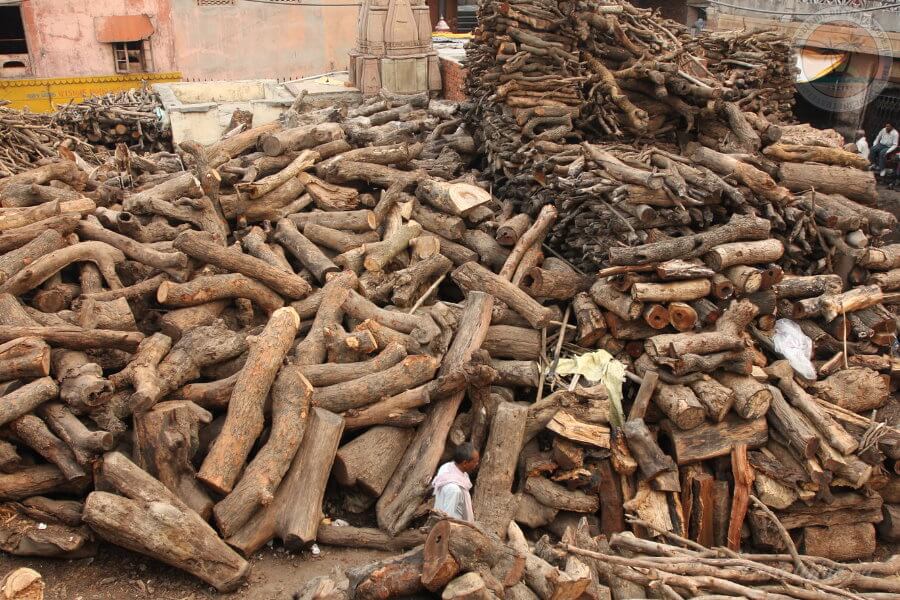
Varanasi: city of farewells, funeral pyres and kites
EAs we approached the city, we met an Indian on the train, who informed us about housing and prices in Varanasi. He advised me to go to the ghats - all the hotels are located there. Leaving the train and wrapping ourselves in everything that was in our backpacks, because it is quite cool here in winter, we got on a rickshaw and drove to the ghats. Ghats are stone steps that descend to the Ganges River. They stretch along the waterfront of the entire city. The station is located far from the ghats - about ten kilometers.
"Mishra guesthouse" 200 rupees per day, but you can live
Having strayed along the ghats, we met an Indian helper who introduced himself as a student and began to take us to hotels. Helpers here do not take money from tourists, they take a percentage from the owner of the hotel if a foreigner settles in it.

So in Varanasi you can resort to the services of such assistants. Went to several guesthouses. All of them were dirty, located in dark back streets, and the prices there were called astronomical for such housing: 500-600 rupees. Then we told our helper that we need accommodation for 200 rupees. And he took us to the Mishra guesthouse where we stayed.
Mishra guest house is located right on the banks of the Ganges, in the Manikarnika Gata area, at some elevation from it. If you leave the hotel and go down a few meters, you can go to the ghat with funeral pyres. There are always ubiquitous pearl merchants nearby.

The first floor of the establishment is very cold, with concrete walls and no heating. The owner brought us woolen blankets. Damp draws from the Ganges. Hot water was given once a day for a couple of hours. But this is also good for India.

The lights were switched off regularly for several hours. On the ground floor of the hotel there is an internet cafe (40 rupees per hour). What I liked about this hotel is that there is a library downstairs - Lonely planet and other books in different languages. Here you can change books - take any book you like, and leave your own in return. On the top floor there is a cafe where they cook not only Indian, for example, my favorite pav bhajibut also European food. Spaghetti, salads, pancakes for 60 rupees and decent coffee.
The Great Ganges is a real river of life and death
Every day, strings of Hindus march to the sacred banks of the Ganges. Many men and women shave their heads before bathing. Then they go down the steps to the river and plunge into the water. Having bathed, they wash things that are carried in large bales. The Ganges is a sacred river for Hindus, and people come here to take a bath to purify themselves.

According to legend, Varanasi is a city founded by Shiva himself 5,000 years ago. Pilgrims distribute alms to beggars who sit here on the embankment, visit temples and bathe in the Ganges. The women bathe in saris and the men in loincloths. All clothes are then spread out on the stone slabs of the embankment or hung on fences and, thus, dried.

Sometimes the narrow streets that stretch along the embankment are so filled with pilgrims that it is simply impossible to walk along them. Hindus stand in line at some temple, and this line blocks all traffic along the street.
The last journey and the funeral pyres of the Ganges
For Hindus, it is believed that dying in Varanasi is a great success, so many people come here to die.

Funeral processions are visible around the city. The bodies are carried on special stretchers, while mantras are sung. Relatives buy specially prepared firewood on the embankment. They are weighed with huge scales. When everything is ready, the corpse is laid on firewood, smeared with a flammable liquid, and set on fire. The body is completely burned in about an hour.

Anyone can come closer and watch the fire. When the fire burns out, its remains are thrown into the Ganges, and a new body is put in its place. Thus, bonfires have been burning in Varanasi without ceasing for several centuries in a row.
Ganga puja ceremony
Many temples are scattered along the banks of the Ganges. There are Hindu and Vaishnava temples. Every evening, in some temples, a puja is held - a ceremony of offering fire to the Ganges.

The largest puja is held at Dasashvamedh gata. Four brahmins stand on a pedestal and sing kirtans. They light a fire and, with the help of special movements and prayers, offer it to the river.
Fire offering ceremonies are also held at other ghats, but on a smaller scale. Every evening, around 19:00, the ghat is flooded with people - pilgrims and tourists who want to look at this bewitching sight, as well as beggars of indiawho want to make money.

Some boaters offer to watch the puja ceremony from the water. So did we. They took a boat for 100 rupees an hour and sailed to the place of the ceremony. From the side of the river, it turns out that the brahmins are turned to face you - the puja is seen in a completely different way than from the shore.

A seller of candles swam up to us. He offered to buy small candles with flowers, light them, and lower them into the Ganges. So we made our little offering to the great river.
Streets of the ancient city of Varanasi
The urban development of Varanasi is a labyrinth - narrow streets called gali. If you stretch out both hands, you can reach the opposite houses with your fingertips.
At first, navigating these narrow streets is a bit of a problem - you don't remember where you came from and where you need to go. But over time, you can begin to navigate the shops and shops. And some guesthouses draw arrows with the name of the guesthouse on the houses, so that it is clearer how to get to it. But, of course, there are ordinary streets with a unique Indian flavor and sacred cows.

But walking through the labyrinths is already a whole adventure. Every now and then Indians on a motorbike pass through them. You need to have time to dodge before they crushed. Here again the sacred cows walk, lie and empty themselves, creating congestion and real dirt and rubbish in india. Processions with the dead go along the lanes, they carry firewood, pilgrims go for ablutions, believers stand in lines at temples.
Kites Varanasi
Varanasi in India could be called the city of kites. Folk entertainment for the local population. Snakes are sold downstairs at the stalls. When you go up to the roof of the hotel and look at the city, it seems that no one works here.
Everyone is just busy flying kites. Thousands of kites soar over the city at the same time. They are launched from the streets, windows of houses, from balconies and roofs.
Men and women, children and old people - all people are busy with one thing - so that their snake turns out to be the strongest and most persistent. If someone else's snake got on someone's roof or balcony, then he is captured.
Varanasi is a truly powerful place. And it is very different from other places in India with its energy. The atmosphere here is special, unique. It's hard to find words to describe this city. As soon as you get here, at first you do not believe that all this can be real. And then you understand - no, all this is not window dressing, the real travelgide.ru. Everything is just like that…


